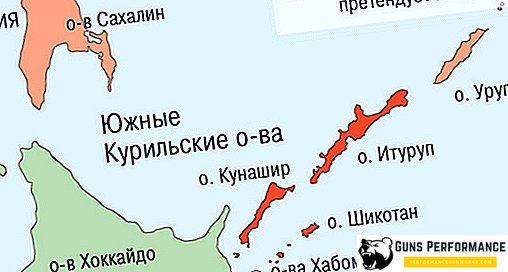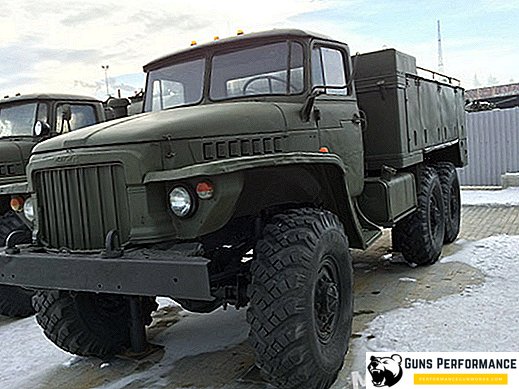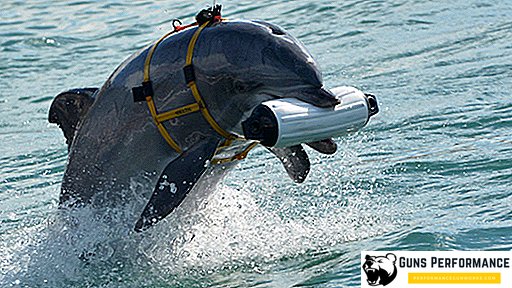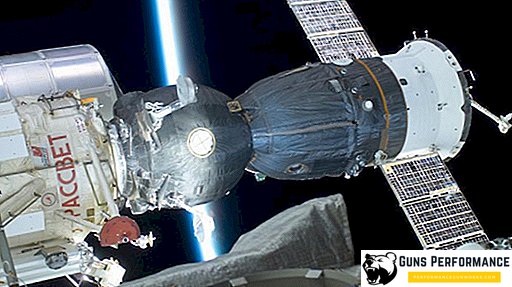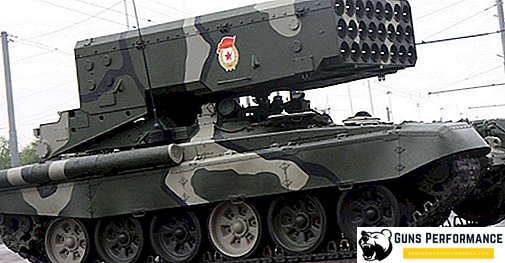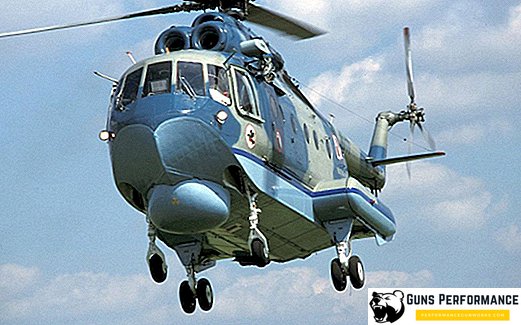
The Mi-14 is a Soviet multipurpose amphibious helicopter developed at the Mil Design Bureau in the early 1970s based on a Mi-8 helicopter. Such a machine was badly needed by the Soviet Navy to fight the enemy’s submarines. However, the Mi-14 helicopter was widely used for peaceful purposes: for transporting passengers and cargo, conducting search and rescue operations, and extinguishing forest fires. Mi-14 is a coastal helicopter.
Serial production of the Mi-14 was established at the Kazan Aviation Plant, it lasted until 1986. A total of 273 cars were produced. Successful technical solutions that appeared during the creation of the Mi-14, later found use on other machines of the Mil Design Bureau: Mi-8MT and Mi-24.
The pilots were very respectful of this machine, calling it a “liner” for its convenience. The helicopter was notable for very insignificant vibration, comfortable cabin and high reliability.
The amphibious helicopter Mi-14 is still in use in Russia, although officially it was removed from service of the Russian Navy. This machine is used in other countries: in Ukraine, Georgia, Cuba, Poland, Libya and a number of other countries.

The history of the Mi-14
The idea of using helicopters to combat submarines arose almost immediately after the appearance of these helicopters. It happened at the end of the Second World War. The pioneers in this field were the Americans, although the Germans tried to adapt the FI 282 ultralight autogyro for this purpose.
Helicopters were perfect for solving such problems: the helicopter could arrive in the area of the intended location of the submarine much faster than the surface ship, the helicopters had a greater search speed, they could be deployed directly to the coastal bases without the need to build expensive airfields, and they could be equipped with combat the ships. And no less important was the fact that the use of helicopters in anti-submarine defense was cheaper than surface ships.
After the war, the USSR and the United States began to accelerate the development of submarine forces, which included submarines with nuclear power plants and nuclear weapons on board. The danger of submarines has increased many times, the submarine fleet has become a strategic weapon.
Accordingly, the opposing sides began to actively develop anti-submarine defense. In this direction, the arms race helicopters quickly took a worthy place.

In the early 50s, the famous Sikorsky firm based on the S-55 multipurpose vehicle developed the H04S-1 anti-submarine helicopter, and several years later the Sikorsky H-34 entered the American Navy, which was equipped with a very advanced set of equipment for detecting submarines. Around the same period, the UK also created its anti-submarine helicopter, and in the early 1960s, the American fleet received the famous SH-3A Sea King helicopter.
The Soviet Union had a lag in this area. Helicopters for the Navy have traditionally been engaged in the Kamov Design Bureau, but for a long time, Soviet vehicles were significantly inferior to their foreign counterparts.
In the mid-60s, the Soviet Navy needed an anti-submarine defense helicopter, which would be created on the basis of an existing reliable machine, to protect its own coast. The sailors wanted it to be as good as the SH-3A Sea King’s American helicopter. The optimal machine for use as a basis was recognized as the newest at the time multi-purpose helicopter MI-8.
An important fact was the fact that the designers of the Mil Design Bureau thought about the anti-submarine version of the Mi-8 several years before the first prototype of this vehicle was manufactured. Among several options that were worked out by specialists, was an amphibious helicopter.
The design of the helicopter began in 1962. The Ministry of Defense required that the new machine could search for submarines in all weather conditions, day or night, at a distance of 200 km from the coast and hit them at depths of up to 400 meters at a speed of 30 knots.

Work on the new machine was rather slow, the customer repeatedly changed his requirements for the helicopter. Only on April 30, 1965, a government decree appeared on the creation of a new amphibious helicopter, which received the designation B-14. It was decided to equip a new car with a more powerful TVZ-117M engine, which was yet to be created.
Glider B-14 had significant differences from the Mi-8. First of all, this concerned the bottom of the boat and side floats, which provided the helicopter with the ability to float on the sea with waves up to 3-4 points. The B-14 received additional fuel tanks, which allowed him to conduct long air patrols. This machine was the first Soviet helicopter with retractable landing gear. Unlike the Mi-8, the engines were started at the expense of a separate power plant.
In June 1967, factory tests of the helicopter began. On August 1, a new car took off for the first time. At this stage, deficiencies were identified, which were eliminated during the construction of the following experimental machines. In 1968, the state testing phase began, during which some changes were also made to the design of the helicopter. They lasted until 1973, when the new helicopter was adopted by the Soviet Navy and received the designation Mi-14.
Deliveries of anti-submarine modification of the helicopter to the fleet began in 1974. After the collapse of the USSR, most of the Mi-14 went to Russia. In 1992, in connection with the general reduction of the country's armed forces, it was decided to replace the Mi-14 with Ka-27 helicopters. It can be easily explained: the Kamov machine is capable of taking off not only from coastal bases, but also from the ship's deck, in addition, the Ka-27 was equipped with a more modern antisubmarine equipment complex. In 1996, Mi-14PL helicopters were decommissioned from the Russian Navy.

Description of the design of the Mi-14
The Mi-14 helicopter is made according to the classical scheme with one main and one steering propeller, two gas turbine engines and a four-support retractable landing gear. The crew of the antisubmarine modification of the helicopter consists of two pilots and two operators.
The design of the fuselage (its upper part) is similar to the Mi-8, and the lower part of the car is made in the form of a waterproof boat with pronounced cheekbones, side fairings and deadrise. There are two inflatable floats (ballonet) with a volume of four cubic meters.
The cockpit, as in the Mi-8, is located in front of the car. Behind it is a cargo cabin, which occupies a large part of the hull. Unlike the Mi-8, the Mi-14 has no rear cargo door, instead there is a small door for the magnetometer. The radar is located in the nose of the helicopter, and behind it is a weapons bay and hatches through which the hydroacoustic station is lowered and the hydrobuses are dropped.

In the anti-submarine version of the Mi-14 in the same compartment is the equipment that ensures the operation of the magnetometer and sonar station, as well as the operators of these systems.
In the search and rescue modification in this compartment can accommodate up to ten victims, for them are provided folding seats and stretchers.
Mi-14 is equipped with a four-bearing chassis: its main pillars are retracted back to the fairings, and the front ones are recessed into the niches in the fuselage of the car. On the tail boom is a safety bearing with a float.
The design of the main, tail rotor and transmission completely repeats the one that was used on the Mi-8, with some exceptions. For example, the tail rotor was installed on the other side.
The helicopter’s equipment (anti-submarine version) consists of the Initiative-2 radar station, the Oka-2 sonar station, the APM-60 magnetometer, the R-842M radio station (KV-range), the R-860 radio station (VHF range), RV-Z radio altimeter, ARK-9 and ARK-U2 radio compasses, DIPS-15 Doppler meter and AP-34B autopilot. The antisubmarine complex also includes the Lily of the Valley sighting and computing device, the Snegir data transmission equipment, the Float marker buoys. The helicopter is equipped with an automatic control system SAU-14, which allows the machine to hang in one place.
On board the helicopter can be located 36 buoys RGB-NM "Chinara" or eight RSL-N "Willow". Depth bombs and torpedoes that are part of the helicopter’s armament can be placed both in the armament compartment and on external hangers. Most often, Mi-14 helicopters work in pairs, one takes on board sonar buoys and is engaged in prospecting, and the second takes a torpedo or depth charges instead.
The Mi-14PL can even be equipped with a 1 Kt atomic depth bomb, its weight is 1600 kg.

If we talk about the rescue modification (Mi-14PS) of this helicopter, then it carries ten life rafts, each of which can accommodate twenty people, as well as a winch capable of lifting three people. The helicopter is equipped with several searchlights. This modification can be used for passenger transportation, and for the landing of troops, and for cargo shipments. On the car, you can install additional fuel tanks.
Modifications of the Mi-14
The Mi-14 helicopter was repeatedly upgraded, now there are numerous modifications of the machine. Below are the main ones:
- Mi-14BT. Modification of the helicopter, designed to tow mine trawls. This machine provides towing of contact and contactless trawls of various types. Towing can be carried out as one helicopter, and a couple of cars.
- Mi-14GP. Modification intended for the carriage of passengers and cargo.
- Mi-14P. Passenger version of the helicopter, capable of carrying up to 24 people. The modification was developed to service oil development on the Caspian shelf in 1995.
- Mi-14PZH "Eliminator". Modification of the helicopter, designed to extinguish fires. The machine is based on the modification of the Mi-14BT. The development was carried out jointly with the German company Aerotech. A water tank is installed in the cockpit of the helicopter, and it is drained through opening flaps. One machine was built, it was used during fire extinguishing in Spain.
- Mi-14PL. Anti-submarine helicopter, is the most massive modification of the machine.
- Mi-14PLM. The upgraded version of the Mi-14PL, on which they planned to install the Octopus onboard equipment and equip it with the latest Orlan and Kolibri anti-submarine torpedoes at that time. Work on the creation of this modification has not been finalized.
- Mi-14PW. Polish modification antisubmarine helicopter.

Current situation
Currently, the Mi-14 is the only domestic amphibious helicopter. With the armament of the Russian Navy, this machine is removed, it is limitedly used for the transport of passengers and in the MOE. Currently, these helicopters are operated in Poland, Ukraine, Georgia.
Repeatedly in the media appeared information about the possible resumption of serial production of the Mi-14. The last time this question was raised in 2018. The company "Helicopters of Russia" presented a project to resume serial production of the Mi-14. The company plans a deep modernization of the machine and the release of its military and civilian modifications.

Characteristics of performance characteristics of the Mi-14
| Modification | Mi-14PL |
| Length m | 18,30 |
| Width, m | 3,8 |
| Height, m | 6,93 |
| Weight, kg | |
| empty | 8902 |
| Max. takeoff | 13000 |
| Max. takeoff | 14400 |
| engine's type | 2 GTD Klimov TV3-117M |
| Power, hp | 2 x 1950 |
| Maximum speed, km / h | 230 |
| Cruising speed, km / h | 215 |
| Practical range, km | 970 |
| Range, km | 200 |
| Patrol time, h | 3 |
| Practical ceiling, m | 4000 |
| Crew | 4 |
| Armament: | Anti-submarine torpedoes and depth charges |



